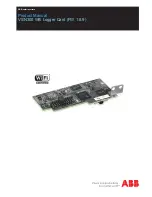
NetScan User’s Manual
Calibration 6-5
System Inventory
2.
Select the Inventory icon from the toolbar to generate a list of items that make up your scanning
system.
3.
Select the items you wish to calibrate.
Calibration
4.
Select the Calibration icon from the toolbar to initiate the automatic calibration process. The ScanCal
program will prompt you through the calibration. Be ready to supply the corresponding passwords
when prompted by ScanCal.
ScanCal contains a feature that allows you to view the calibration steps without performing an
actual calibration. This is accomplished by using the Skip this Step button to skip a procedural
step(s). When using this feature the existing calibration settings will not change.
Calibration Without ScanCal
Password
To perform calibration, the calibration mode must be enabled. The Enter Calibration Mode (
K
) command
enables calibration, where
keyword
is the five-digit keyword (or password) currently configured for the
unit. Your scanning unit is shipped with a default password of
12345
. This password can be modified by
the Change Calibration Keyword (
*K
) command, once Calibration Mode has been entered. Calibration
mode is ended by executing the End Calibration Mode (
E
) command.
Attempts to execute calibration commands without entry into calibration mode will result in a
calibration status error.
If the password is lost or forgotten, a new password can be entered after enabling the calibration mode.
This mode is enabled by indenting the Calibration Enable/Disable Pushbutton. After pushing in the button,
execute the
*K
command to change the existing password. For more information, refer to the
Hardware
Protected RAM
section on page 6-2.
Disable writing to RAM after successfully changing the password by setting the Calibration
Enable/Disable Pushbutton to the disable (non-indent) position.
Note to ChartScan users: Early production ChartScan units do not have a Calibration Enable/Disable
Pushbutton. For these units the calibration mode is enabled by positioning the DIP switch right-most micro-
switch (#9) to the “1” (up) position. Note that ChartScan units with the pushbutton have it located on the rear
panel, as indicated in the NetScan figure (page 6-2).
Mode Indicator
To denote whether or not calibration mode has been activated, bit 7 in the Calibration Status Register will
be set after a valid
K
command has been executed. This bit is cleared by the
E
command (see “
E Command
”
in Appendix A).
You can verify the register status by the
U2
command. A response of
U128
indicates that the unit is in the
calibration mode.
U2,
in the command reference section (Appendix A) contains details regarding this
command.
Command Active Indicators
Since the calibration commands require a few seconds to complete, bit 6 in the Calibration Status
Register will be set and the trigger LED will flash to indicate that a calibration command is active.
When these indicators are off, a subsequent calibration step can be started.
Summary of Contents for OMB-NETSCAN 1500
Page 6: ...iv NetScan User s Manual...
Page 18: ...1 12 Configuring and Starting NetScan NetScan User s Manual Notes...
Page 38: ...3 8 General Information and Specifications NetScan User s Manual Notes...
Page 82: ...4 44 ChartView Software Reference NetScan User s Manual Notes...
Page 118: ...6 20 Calibration NetScan User s Manual...
Page 140: ...A ii NetScan User s Manual...
Page 192: ...API Command Reference Appendix A A 52 NetScan User s Manual Notes...
Page 237: ...Appendix D Registers Data Formats Queries NetScan User s Manual D 13...
Page 244: ...NetScan Program Examples Appendix E E 2 NetScan User s Manual...
Page 248: ...ASCII Code Summary Appendix F F 4 NetScan User s Manual Notes...
Page 250: ...NetScan Error Messages Appendix G G 2 NetScan User s Manual Notes...
Page 252: ...Abbreviations Appendix H H 2 NetScan User s Manual Notes...
Page 254: ...NetScan User s Manual...
















































